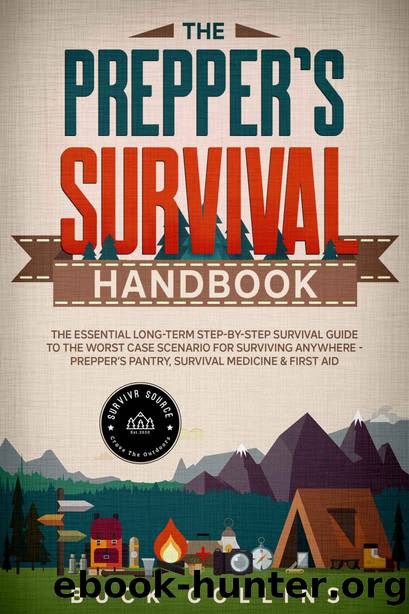The Preppers Survival Handbook: The Essential Long Term Step-By-Step Survival Guide to the Worst Case Scenario for Surviving Anywhere - Prepper's Pantry, ... Medicine & First Aid ( by Buck Collins & Survivr Source

Author:Buck Collins & Survivr Source [Collins, Buck]
Language: eng
Format: azw3
Published: 2020-04-15T00:00:00+00:00
Scenario 4: The Feud
You and your kid are digging in the garden on a hot day. They are sullen because they had a fight with their sibling, who is moping in their room. Youâve been outside for a few hours and you decide to call it quits. Your child decides to stay. After you are refreshed, you go back out to check on them and right away you notice they appear dazed. They are slumped over the hoe and when you ask whatâs wrong, they say, âNothing, Iâve just got a headache.â
You offer them a drink of water and ask them to come out of the heat.They take one look up at the house, see their sibling sticking their tongue out at them, and refuse to go inside. You approach and put your hand on their forehead. They are quite hot and their cheeks are flushed. They push you away, bent on their work. You can see sweat stains all down their shirt, but still they say they wonât stop until the garden is finished.
Insisting that they at least get to the shade, you promise to bring them a sweet drink. However, none of your coercing works. You try to grab their hand and physically bring them out of the sweltering heat. Your childâs speech is now confused, they are lashing out angrily and they look like they might puke. They are suddenly pale and when you touch them again, their skin is bone dry. You scoop the child up now that they are losing strength and you head into the house. You remove any constricting clothing, and place the child in the recovery position. Call 911 if available and then call your other child to get some wet towels to drape over their body. Turn on a fan full blast, or physically fan them with a damp cloth.
Hyperthermia doesnât happen as fast as this, but it can still surprise you, especially if you are distracted, or working. Luckily, our bodies go through stages and so there are signs along the way that we must pay attention to. The temperature, colour and feel of the skin will be the biggest indicators. Hot, sweaty, flushed skin means the person is at risk and needs to find shade and drink fluid; water with electrolytes is best. Hot, pale, dry skin means the person is in heat-stroke and will possibly go into shock, or worse, have a seizure. Do not offer fluids or food to someone who is in shock or is unresponsive. Cool them down and keep them in the recovery position. Keep an eye on their symptoms.
Hypothermia occurs with a similar degradation. First the person will shiver, they will have cold or numb extremities and they may feel weak or drowsy. Then their breathing might slow and their pulse will grow weak. Similar to hyperthermia, the person may become confused or dizzy and their speech may be slurred or fumbled. They may paradoxically start to remove clothing, at which point you should be very concerned.
Download
This site does not store any files on its server. We only index and link to content provided by other sites. Please contact the content providers to delete copyright contents if any and email us, we'll remove relevant links or contents immediately.
Periodization Training for Sports by Tudor Bompa(7995)
The Body: A Guide for Occupants by Bill Bryson(4704)
The MacArthur Bible Commentary by John MacArthur(4666)
The Sports Rules Book by Human Kinetics(4141)
What It Really Takes to Get Into Ivy League and Other Highly Selective Colleges by Hughes Chuck(3586)
Marijuana Grower's Handbook by Ed Rosenthal(3549)
The Sprouting Book by Ann Wigmore(3461)
The Martian by Andy Weir(3220)
Salt, Fat, Acid, Heat: Mastering the Elements of Good Cooking by Nosrat Samin(3038)
The Bread Bible by Rose Levy Beranbaum(2932)
Sapiens and Homo Deus by Yuval Noah Harari(2897)
Classic by Mary Berry(2877)
Harry Potter 4 - Harry Potter and The Goblet of Fire by J.K.Rowling(2866)
The Marketing Plan Handbook: Develop Big-Picture Marketing Plans for Pennies on the Dollar by Robert W. Bly(2850)
Martha Stewart's Baking Handbook by Martha Stewart(2709)
The Plant Paradox by Dr. Steven R. Gundry M.D(2471)
Screenplay: The Foundations of Screenwriting by Syd Field(2465)
50 Economics Classics by Tom Butler-Bowdon(2447)
The Cambridge Grammar Of The English Language by Rodney Huddleston Geoffrey K. Pullum(2336)
